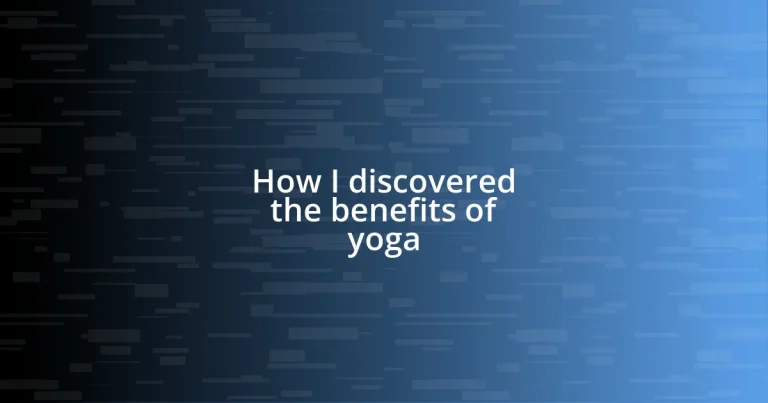Key takeaways:
- The author’s journey into yoga began as a response to stress, leading to self-awareness and emotional balance through practice.
- Key principles of yoga like ahimsa (non-violence), pranayama (breath control), and sankalpa (intention setting) significantly transformed the author’s mindset and physical capabilities.
- The incorporation of yoga into daily life provided tools for managing stress, fostering community connections, and enhancing both mental clarity and physical well-being.
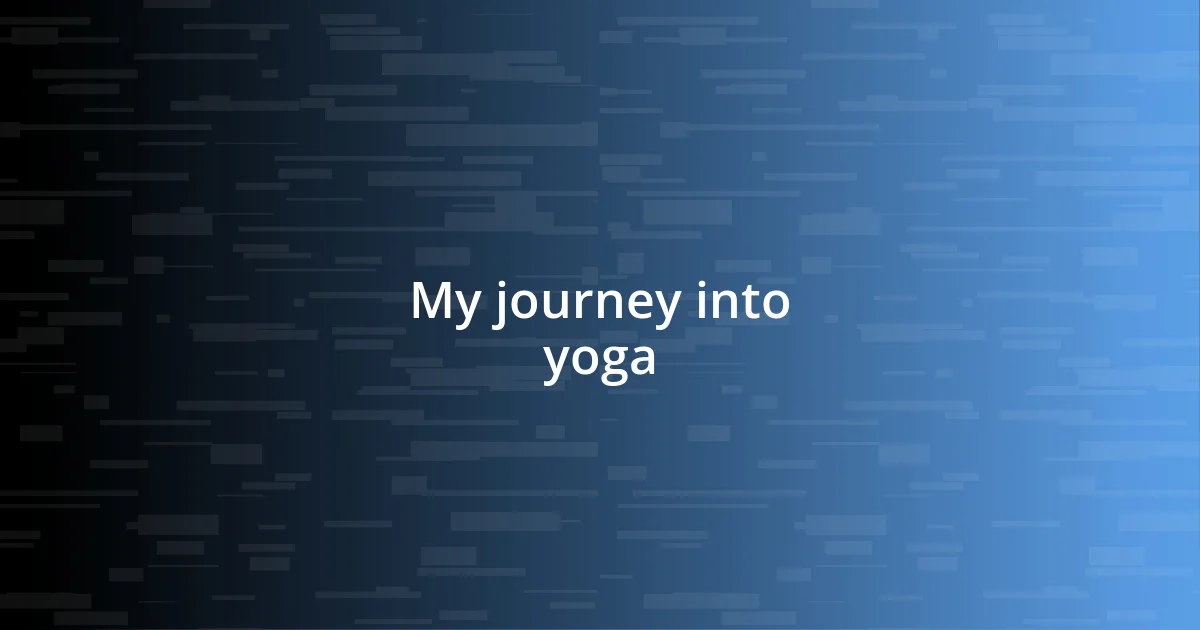
My journey into yoga
My journey into yoga began during a particularly stressful phase in my life. I remember sitting at my desk, drowning in deadlines, when a friend casually suggested I try a yoga class with her. Honestly, I was skeptical; would bending my body help with my never-ending to-do list? But something pushed me to join her, and that first class changed everything.
As I unrolled my mat, the weight of the world felt momentarily lifted. I recall the soothing atmosphere and the instructor’s calm voice guiding us through poses I struggled to master initially. I found the first few classes challenging—but also strangely liberating. In those moments, as I focused on my breath and movement, it felt like I was creating a safe space just for me, away from all the chaos.
With each session, I discovered layers of tension melting away. It was more than just the physical practice; it was a journey into self-awareness. Who knew that something as simple as a downward dog could unlock emotions I had buried deep? I often wonder, did I come to yoga for flexibility, but stay for the emotional balance? It became clear that this path was exactly what I needed, opening doors to insights I hadn’t anticipated.
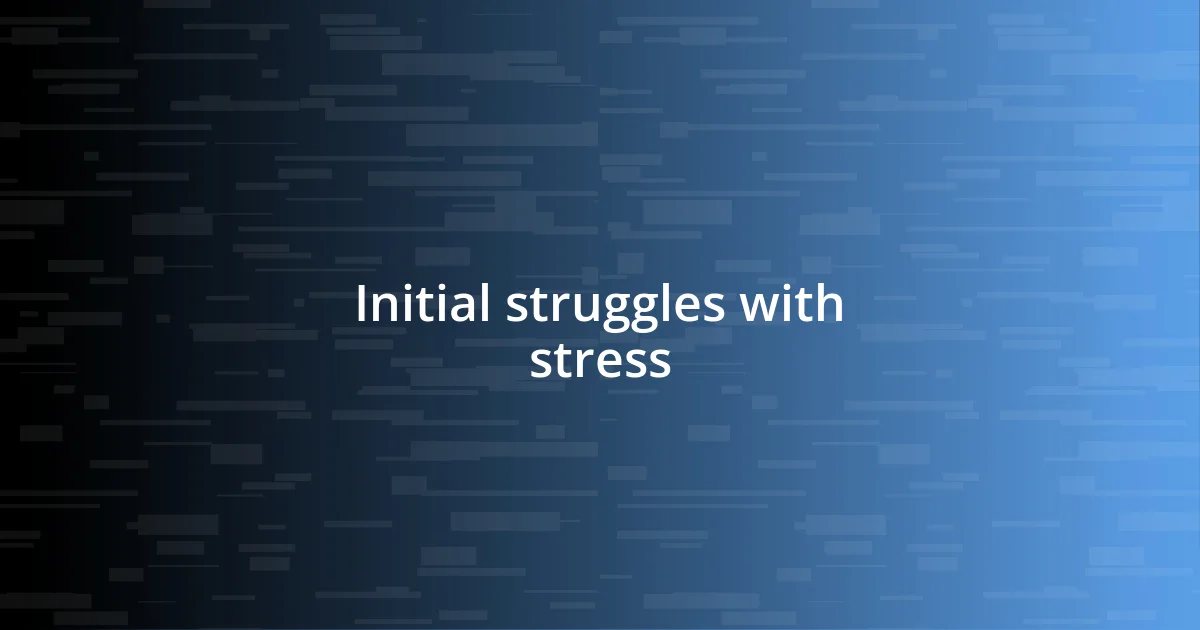
Initial struggles with stress
The onset of stress often crept in unnoticed, like a slow tide washing over me. I felt overwhelmed, constantly juggling work and personal life. I often experienced restless nights, with my mind racing through unresolved tasks. It was in those quiet moments, while staring at the ceiling, when the weight of stress truly hit me.
- My heart raced at work presentations, leaving me with a sense of impending doom.
- I often found myself snapping at loved ones over trivial matters, my patience worn thin.
- Social events became daunting; I’d dread being around others, even friends.
- I constantly battled fatigue, feeling like I was running on empty all the time.
It was a bleak existence. I began realizing that I needed an outlet—a way to reconnect with myself and alleviate the mounting pressure.

Understanding yoga’s core principles
Understanding yoga’s core principles goes beyond the physical postures; it encompasses a philosophy rooted in balance and mindfulness. One aspect that truly resonated with me was the principle of “ahimsa,” or non-violence. This isn’t just about being kind to others; it’s also about how we treat ourselves. When I started yoga, I noticed a shift in my inner dialogue. I began to emphasize self-compassion instead of criticism. Have you ever been unexpectedly harsh on yourself? I have, and embracing ahimsa has allowed me to replace those thoughts with a kinder, more nurturing perspective.
Furthermore, the concept of “pranayama,” or breath control, plays a pivotal role in yoga practice. Initially, I underestimated the power of breath. I remember struggling through a challenging pose when my instructor asked us to focus on our breathing. Suddenly, it felt as if the chaotic world around me paused, and there was clarity. The simple act of inhaling deeply and exhaling fully became a tool for grounding myself amidst life’s turbulence. This connection between breath and movement transformed my practice and, more importantly, my response to stress.
Lastly, the principle of “sankalpa,” or intention setting, serves as a guiding light in my yoga journey. Before each practice, I now take a moment to set a personal intention, whether it’s to cultivate patience or to embrace gratitude. This practice has not only deepened my experience on the mat but also encouraged me to carry that intention into my daily life. Have you tried setting intentions before undertaking tasks? I can’t recommend it enough, as it creates a sense of purpose that can shift your entire mindset.
| Yoga Principle | Description |
|---|---|
| Ahimsa (Non-Violence) | A principle emphasizing self-compassion and kindness towards oneself and others. |
| Pranayama (Breath Control) | The practice of controlling breath, crucial for grounding and focus during yoga. |
| Sankalpa (Intention Setting) | Setting a personal intention before practice to cultivate purpose and mindfulness. |
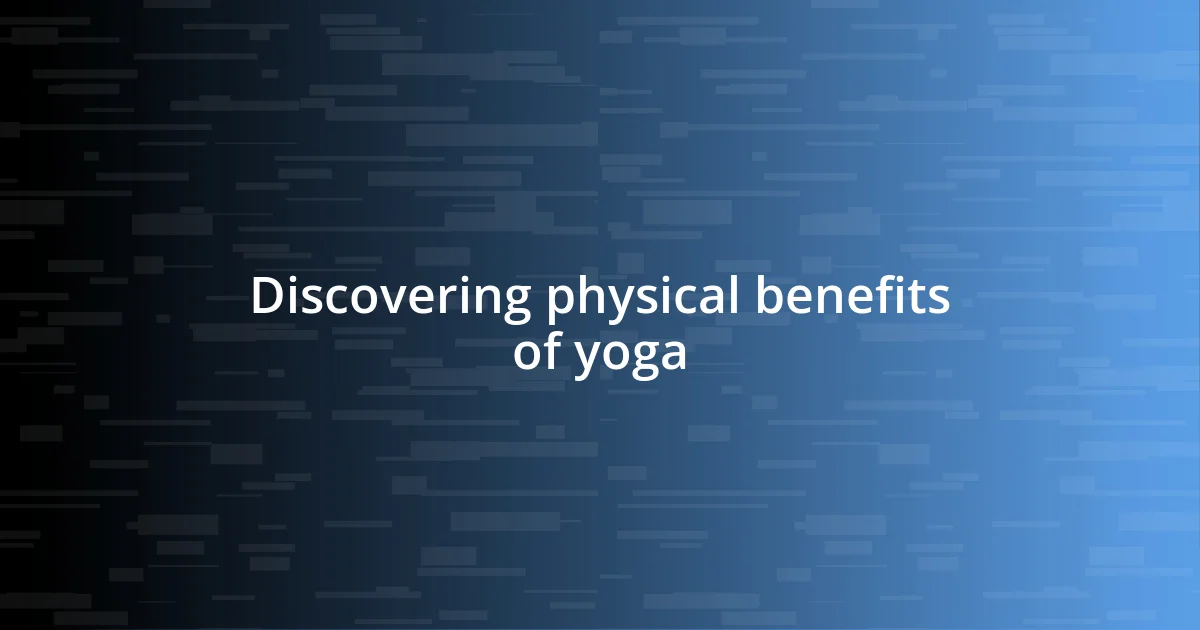
Discovering physical benefits of yoga
When I first began practicing yoga, I quickly noticed how my body started to respond positively. Poses that once seemed impossible—like downward dog—became not just achievable, but exhilarating. I remember standing in that posture and feeling a delightful stretch through my hamstrings and calves. It struck me right then how this physical engagement was forging a deeper connection between my body and mind. Have you ever felt the euphoric release of tension after a good stretch? It’s a sensation like no other.
Gradually, the increased flexibility began to influence my everyday activities. Simple tasks like bending down to tie my shoes turned from awkward maneuvers into graceful actions. I found myself moving with a newfound ease that I hadn’t experienced in years. It’s interesting how such a simple change can uplift your spirit. I recall venturing on a hike soon after and discovering that I could navigate steep inclines without feeling winded. It was empowering—almost as if my body was thanking me for the newfound care and attention it received through yoga.
Building strength was another revelation in my practice. The first time I managed to hold a plank for more than a minute, it felt monumental. I remember finishing that session and thinking, “Wow, I really did that!” This confidence translated beyond my yoga mat; I started taking on challenges I would have previously shied away from. Have you ever felt such determination wash over you after accomplishing something you thought was out of reach? For me, it wasn’t just about yoga; it embodied the idea that physical strength can deeply influence our mental fortitude, reshaping how we approach life’s hurdles.
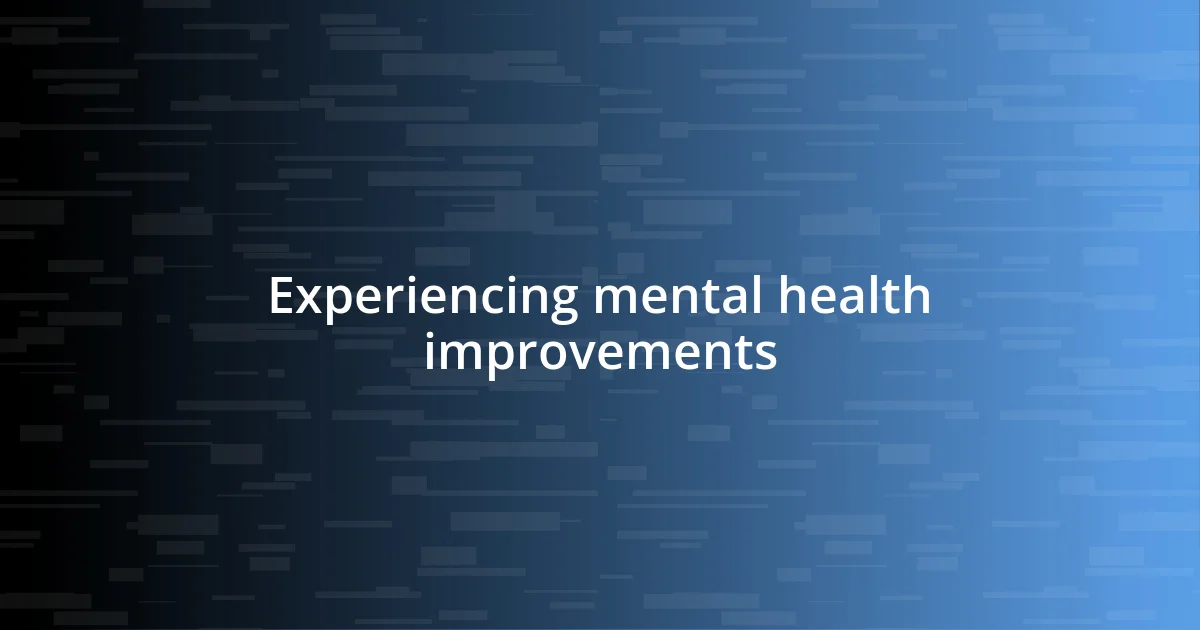
Experiencing mental health improvements
Experiencing clearer thoughts became a surprising gift when I dove into yoga. I remember one specific session where my mind felt like a chaotic storm, filled with worries and distractions. But then, as I followed a series of gentle stretches and focused on my breathing, suddenly everything calmed down. It’s as if the overwhelming fog lifted, and I could think more clearly. Have you ever experienced that moment where clarity just washes over you? I certainly have, and it’s a freeing sensation that I’ve come to cherish.
Another fascinating aspect was how yoga encouraged me to confront my anxieties head-on. I recall a day when I felt particularly anxious about an upcoming presentation. Instead of letting that anxiety consume me, I turned to my mat and practiced a few grounding poses. Each stretch was a way to release the tension I held in my body, and with every breath, I felt that tightness ease up. The fear didn’t vanish entirely, but it shifted from a paralyzing force to a manageable shadow, reminding me I’m human. Isn’t it amazing how a simple practice can shift our mindset toward what feels overwhelming?
As I continued my journey in yoga, I noted the importance of community in bolstering my mental health. I started attending classes with others, and those shared experiences fostered a sense of belonging. One evening, laughter broke out among my classmates during a particularly tricky balance pose. It reminded me that we’re all in this together, facing our struggles and triumphs, no matter how small. The connections I built in those moments brought me comfort and joy, reinforcing that mental well-being isn’t just a solo endeavor. Have you felt uplifted by being part of a community like that? It’s a powerful reminder of the support we can find when we open ourselves up to others.
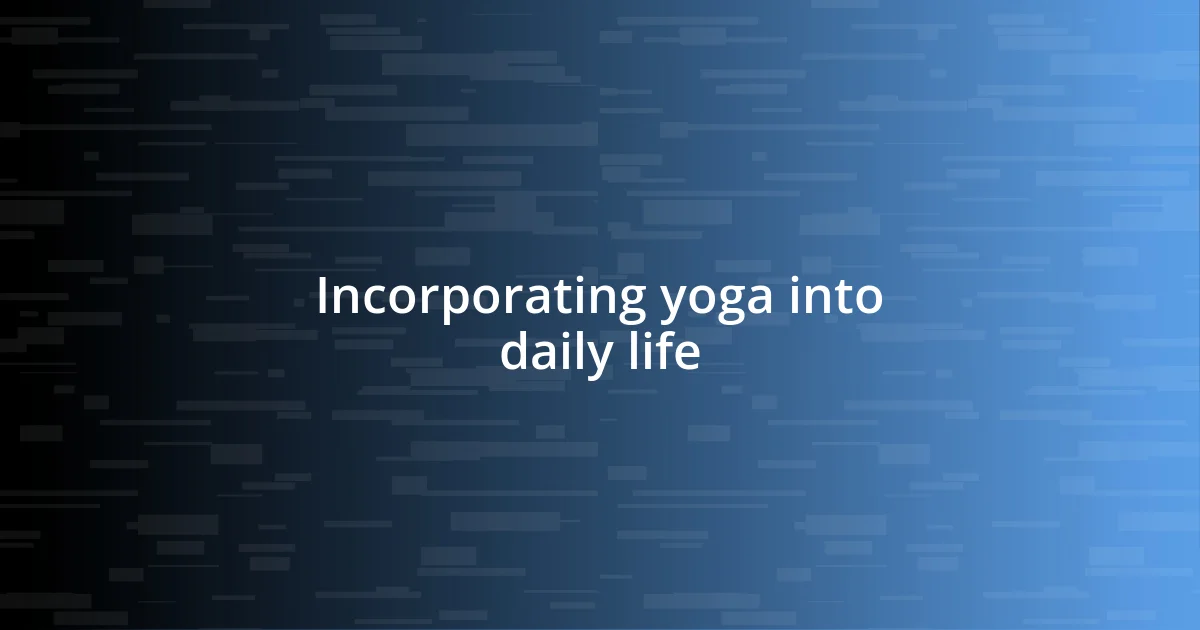
Incorporating yoga into daily life
In my experience, incorporating yoga into my daily routine felt like adding a little bit of magic to my mornings. I started by setting aside just 10 minutes each day, unrolling my yoga mat right next to my bed. As I moved through gentle stretches, I discovered that this simple act shifted my mindset for the day ahead. Have you ever noticed how the energy of the morning can set the tone for everything that follows? That clear, calm feeling lasted long after I rolled up my mat.
I also found that yoga wasn’t just a morning ritual; it seamlessly blended into moments throughout my day. Whether it was taking a few deep breaths before a work meeting or practicing a standing pose during a break, I discovered that these small acts of mindfulness added layers of calm amidst daily chaos. It’s incredible how just a few minutes can ground you, isn’t it? I once took a quick break at my desk to try a seated twist, and I felt the stress of deadlines melt away. It was a gentle reminder that I could reclaim power over my day, even in the midst of busyness.
A significant turning point for me was realizing that yoga can also be a bedtime routine. After those chaotic days, I started integrating restorative poses before sleep. I vividly remember easing into Child’s Pose, allowing my body to release the tension accumulated throughout the day. The physical stretching intertwined with emotional release, creating an atmosphere of serenity. Have you ever laid down for sleep and felt like all your worries just vanished? This practice became my nightly sanctuary, transforming my sleep into a restorative experience. Yoga isn’t just about the poses; it’s about weaving a tapestry of mindfulness and self-care that fits into the fabric of our daily lives.
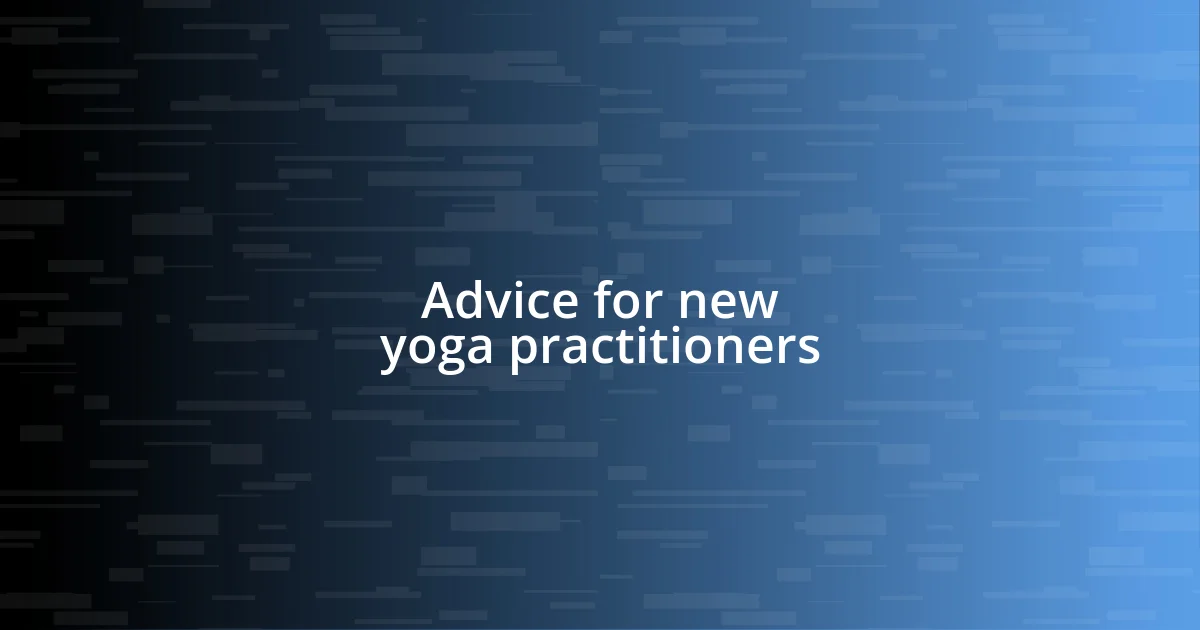
Advice for new yoga practitioners
Adopting a yoga practice can be quite overwhelming at first, especially for beginners. I remember stepping into my first class, feeling a mix of excitement and anxiety. My advice? Don’t hesitate to ask questions! Instructors generally appreciate when newcomers seek clarification. I vividly recall asking about a pose I was struggling with, and the teacher’s supportive guidance not only improved my practice but also built my confidence. Have you ever considered how a simple question can unlock a world of understanding?
One of the most valuable lessons I’ve learned is to listen to your body. It’s easy to feel the pressure to keep up with others, but yoga is about personal growth and self-acceptance. I once pushed myself into a pose that felt too intense, leading to discomfort. After that experience, I realized that honoring my own limits was far more rewarding. How often do we forget to check in with ourselves? Making it a habit to tune in can transform your practice into a deeply personal journey.
Lastly, I encourage you to find joy in the journey. Celebrate the small milestones, whether that’s mastering a pose or simply feeling more relaxed. I remember the thrill I felt the first time I held a balance pose without wobbling. It’s about progress, not perfection. Have you ever paused to appreciate your own growth? Every step forward, no matter how small, deserves recognition, and embracing that joy can lead to a fulfilling yoga experience.












